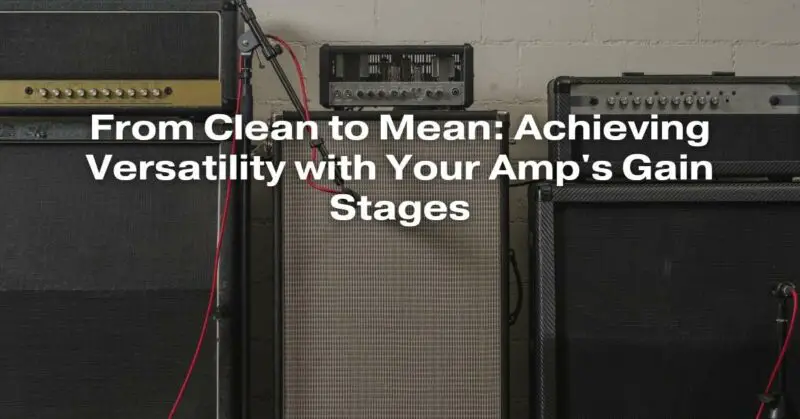The electric guitar is a versatile instrument capable of producing a wide range of tones, from clean and pristine to gritty and distorted. One of the key factors that influence the character of your guitar’s sound is the amplifier’s gain stage. Gain stages are a critical part of any amplifier’s circuitry, and understanding how they work can help you unlock a world of sonic possibilities. In this article, we will explore the concept of gain stages, their role in shaping your guitar tone, and how you can use them to achieve a versatile range of sounds.
What Are Gain Stages?
Before diving into how gain stages affect your tone, let’s start with a basic definition. Gain stages are sections of an amplifier’s circuitry that amplify the incoming signal from your guitar. These stages are responsible for increasing the signal strength and, in the process, can add various degrees of distortion to the sound.
In a typical amplifier, you will find two main types of gain stages:
- Preamp Stage: The preamp stage is the first stage in the amplification process. It takes the relatively weak signal from your guitar’s pickups and amplifies it before sending it to the next stage. The amount of amplification and distortion introduced in the preamp stage can be adjusted using the gain control, often labeled as “Volume,” “Gain,” or “Drive.”
- Power Amp Stage: After the signal has been amplified in the preamp stage, it goes to the power amp stage. This stage further increases the signal’s power to drive the speakers and produce sound. While it doesn’t add as much distortion as the preamp stage, the power amp stage can still contribute to the overall character of the sound.
The Clean Spectrum
Now that we understand the basics of gain stages, let’s explore the spectrum of tones they can help you achieve, starting with the clean end of the spectrum.
1. Clean Tone: When the gain controls on both the preamp and power amp stages are set to low levels, you get a clean and transparent tone. This is often described as a “sparkling” or “crisp” sound. It’s characterized by the absence of significant distortion or clipping, allowing the natural qualities of your guitar and pickups to shine through.
2. Low Gain Blues: As you increase the gain in the preamp stage while keeping the power amp stage relatively clean, you enter the realm of low gain blues tones. This is where you start to hear a bit of grit and warmth in your sound, reminiscent of classic blues and rock tones. It’s a sweet spot for expressive playing.
3. Crunchy Rhythms: Pushing the preamp gain further into the moderate range while maintaining a cleaner power amp stage results in a crunchy rhythm sound. This is the foundation of many classic rock and hard rock guitar tones. The sound is characterized by a pleasing mix of clean and distorted elements, ideal for rhythm guitar work.
The Mean Spectrum
Now, let’s turn up the heat and explore the meaner side of gain stages.
4. High Gain Leads: Cranking up the gain in both the preamp and power amp stages leads to high-gain lead tones. This is where you get searing distortion, sustain for days, and a pronounced “crunch” or “buzz” in your sound. It’s the territory of heavy metal and hard rock guitar solos.
5. Metal and Beyond: Beyond high gain leads, there’s the realm of extreme gain. Here, you’ll find the brutal tones favored by metal guitarists. These tones are characterized by massive distortion, incredible sustain, and a wall of sound that can shake the room. Achieving this level of gain often involves using specialized amplifiers or distortion pedals.
Achieving Versatility
The key to achieving versatility with your amp’s gain stages is to experiment and find the balance that suits your playing style and musical preferences. Here are some tips to help you get the most out of your amplifier’s gain stages:
- Start with a Clean Slate: Begin with all your amp’s gain controls set to their lowest settings. This gives you a clean canvas to work from.
- Gradually Increase Gain: Slowly increase the gain in the preamp stage while monitoring how it affects your tone. Find the point where you achieve the desired level of distortion without sacrificing clarity.
- Tweak the Power Amp: Once you’ve dialed in the preamp gain, make subtle adjustments to the power amp gain. This can add depth and dimension to your tone.
- Experiment with EQ: Use the amp’s EQ controls (bass, mid, treble) to shape your tone further. Different settings can drastically alter the character of your sound.
- Explore Additional Features: Many amplifiers come with built-in effects like reverb or tremolo. Experiment with these to add even more flavor to your sound.
- Pedals and Effects: Don’t hesitate to complement your amp’s gain stages with pedals. Overdrive, distortion, and fuzz pedals can take your tone to new heights.
- Listen and Learn: Pay close attention to your favorite guitarists and the tones they achieve. Try to emulate those sounds as a starting point for your own experimentation.
- Recording and Gigging: Keep in mind that the ideal settings for recording in a studio may differ from what works best in a live gig setting. Be prepared to adjust your gain stages accordingly.
Conclusion
Your amplifier’s gain stages are the gateway to a world of tonal possibilities. From pristine clean tones to blistering high-gain leads, understanding how to manipulate these stages can help you craft the perfect sound for your music. The key is to experiment, listen, and adapt your settings to match your playing style and musical genre. Whether you’re a blues player, a rock enthusiast, or a metal shredder, harnessing the versatility of your amp’s gain stages can take your guitar tone to the next level. So, plug in, turn up, and explore the full spectrum of sonic expression at your fingertips.


